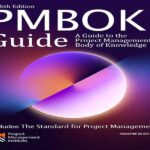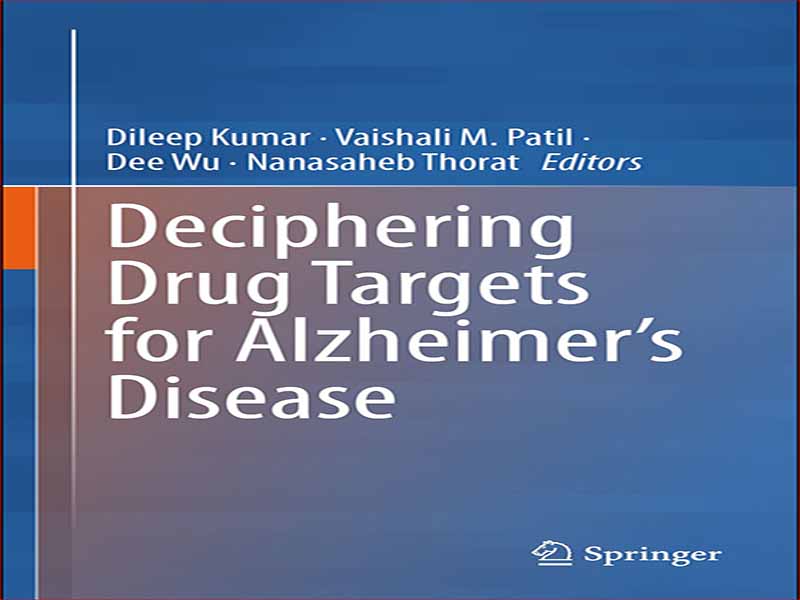- عنوان کتاب: Deciphering Drug Targets for Alzheimer’s Disease
- نویسنده: Dileep Kumar
- حوزه: آلزایمر
- سال انتشار: 2023
- تعداد صفحه: 388
- زبان اصلی: انگلیسی
- نوع فایل: pdf
- حجم فایل: 10.8 مگابایت
بیماری آلزایمر (AD) یک اختلال تدریجی، عصبی و اغلب کشنده است. این بیماری از نظر بالینی با از دست دادن تدریجی حافظه و فرآیندهای شناختی همراه است و در نهایت منجر به مشکلاتی در انجام فعالیت های اولیه می شود. AD یکی از علل اصلی مرگ و میر در کشورهای توسعه یافته است و پیش بینی می شود که در سال 2050 تقریباً 1 تریلیون دلار هزینه داشته باشد، مگر اینکه درمانی برای کاهش/پیشگیری از این بیماری کشف شود. سازمانهای مراقبتی پاسخگو در موقعیت مناسبی برای ابداع استراتژیهای استفاده هستند که تأثیر مثبتی بر تشخیص و درمان زودهنگام داشته باشد و منجر به نتایج بهتر و کاهش قیمتها برای بیماران، مراقبان و مراقبتهای بهداشتی شود. هدف اصلی کتاب با عنوان رمزگشایی از اهداف دارویی برای بیماری آلزایمر، رویکردی جامع بر اساس تحقیقات مولکولی، پیش بالینی، بالینی و ترجمه ای ارائه می کند و در عین حال به اهداف جدید و پیشرفت های اخیر می پردازد. با این حال، پوشش تمام نکات برجسته تحقیقاتی چند رشته ای گسترده در زمینه آلزایمر فراتر از حوزه کاری کتاب خواهد بود. در عوض، کتاب مسیرهای مکانیکی بدیع را روشن می کند، که بدون شک در سال های آینده به طور کامل مورد مطالعه و تثبیت قرار خواهند گرفت. دریافت 15 مقاله استثنایی که توسط تیمی از متخصصان برجسته با تمرکز بر اهداف درمانی مختلف مرتبط با آلزایمر به طرز ماهرانهای این کتاب را تالیف کردهاند، باعث خوشحالی است. هر فصل تلاش می کند تا به ایده های فکری و چالش برانگیزی بپردازد که می تواند برای کسانی که در بخش AD و خارج از آن هستند مورد توجه قرار گیرد. در حال حاضر، درمانهای بالینی مجاز AD شامل استراتژیهایی با تمرکز بر تغییر اهداف گزارششده مختلف مانند استیل کولین استراز (AchE)، آنزیم شکافنده پروتئین پیشساز آمیلوئید 1 (BACE-1)، گلیکوژن سنتاز کیناز 3 (GSK-3ß)، مونوآمین اکسیدازها (MAOs) است. یون های فلزی در مغز، گیرنده N-متیل-D-آسپارتات (NMDA)، گیرنده های 5-هیدروکسی تریپتامین (5-HT) و هیستامین (H3) و فسفودی استرازها. درمان های موجود به بهبود وضعیت بیماری کمک می کند، اما پاتوژنز پیچیده و شبکه پیچیده تشکیل شده توسط مسیرهای سیگنال دهی مرتبط، توسعه درمان کامل را محدود می کند. در فصل اول و دوم، با عنوان «رمزگشایی اهداف دارویی جدید در بیماری آلزایمر» و «هدفهای درمانی جدید برای درمان بیماری آلزایمر»، نویسندگان تأکید جامعی بر اهداف دارویی فعلی و نوظهور از جمله سلولی، هستهای، گیرنده غشایی و میتو دارند. -اهداف کندریال دومی همچنین ویژگی های مرتبط با AD، از جمله اختلال عملکرد میتوکان دریال، و التهاب عصبی را پوشش می دهد. گزارشهای مبتنی بر پیشرفتهای بالینی و بالینی، نیاز به تکنیکهای پیچیده را برای درک مکانیسمهای اساسی پاتوژنز آلزایمر مطرح کردهاند. از نقطه نظر بالینی، چالش دیگر تشخیص و تشخیص نوع و سرعت AD، ابداع رژیم درمانی است. فصل «ابزارها و تکنیکهای بررسی اصلاحشده مفید در تحقیقات بیماری آلزایمر»، تألیف Deore و همکاران، به بررسی روشهای in vitro، in vivo، ex vivo و تکنیکهای تصویربرداری in vivo از مغز میپردازد که برای شناسایی نشانگرهای زیستی آلزایمر توسعه یافتهاند. نویسندگان معتقدند که این روشها در تشخیص و تعیین انواع مختلف آلزایمر جدید و قابل اعتماد هستند. با ظهور فناوری در بخش مراقبت های بهداشتی، چندین مسیر سیگنالینگ به پیشرفت و توسعه AD نسبت داده شده است. فصل «مهارکنندههای کیناز 1A (DYRK1A) تنظیمشده با فسفوریلاسیون تیروزین با ویژگی دوگانه: تلاش برای درمان اصلاحکننده بیماری برای بیماری آلزایمر»، ویژگیهای دوگانه تیروزین را پوشش میدهد، که پروتئینهای تنظیمشده با فسفوریلاسیون کیناز1A (DYRK) توسط سلولهای کیناز1A (DYRK) است. دخالت در درهم تنیدگیهای نوروفیبریلاری (NFTs) و تخریب عصبی تحت کنترل Aβ. DYRK1A نقش نابهنجاری در تجمع پروتئین p-tau و تشکیل پلاکهای آمیلوئید عصبی دارد و آن را به یک هدف شگفتانگیز برای اصلاح بیماری تبدیل میکند. آنزیم بیماریزای مهم بعدی، یعنی BACE-1، یک عامل کلیدی در پیشرفت زوال عقل است و یک هدف جذاب برای طراحی منطقی دارو است. فصل “β-سکرتاز به عنوان یک هدف دارویی اولیه بیماری آلزایمر: عملکرد، ساختار و مهار” ارائه شده توسط Verma و Paramanick، ساختار بیولوژیکی و عملکرد BACE1 را بر اساس پیشرفت های اخیر ارائه کرده است. ویژگیهای مهم فارماکوفور ضروری برای طراحی مهارکنندههای انتخابی مورد بحث قرار گرفتهاند.
Alzheimer’s disease (AD) is a gradual, neurodegenerative, and often fatal disorder. This disease is clinically associated with a gradual loss of memory and cognitive processes, eventually leading to difficulties performing primary activities. AD is one of the leading causes of deaths in developed countries and is projected to cost almost $1 trillion in 2050 unless a therapy to slow/prevent the condition is discovered. Accountable care organizations are in a solid position to devise utilization strategies that would positively impact early detection and treatment, resulting in enhanced outcomes and reduced prices for patients, caregivers, and healthcare. The prime intent of the book entitled, Deciphering Drug Targets for Alzheimer’s Disease,isto present a comprehensive approach based on molecular, preclinical, clinical, and translational research while addressing the novel targets and recent advances. How-ever, covering all the broad multidisciplinary research highlights in the area of Alzheimer’s would be beyond the book’s purview. Instead, the book would shed light on the novel mechanistic pathways, which would undoubtedly be thoroughly studied and established in the years to come. It is gratifying to receive 15 exceptional contributions authored by a team of prominent experts focusing on various thera-peutic targets related to Alzheimer’s skilfully compose the book. Each chapter attempts to address thought-provoking and challenging ideas that could interest those both in and out of the AD sector.
Currently, clinically authorized AD treatments involve strategies focusing on altering various reported targets like acetylcholine esterase (AChE), ß-site amyloid precursor protein cleaving enzyme 1 (BACE-1), glycogen synthase kinase 3ß (GSK-3ß), monoamine oxidases (MAOs), metal ions in the brain, N-methyl-D-aspartate (NMDA) receptor, 5-hydroxytryptamine (5-HT) and histamine (H3) receptors, and phosphodiesterases. Available therapeutics is helping to improve disease condition but the complicated pathogenesis and complex network formed by the associated signalling pathways restrict the development of complete cure.
In the first and second chapters, titled “Deciphering New Drug Targets in Alzheimer’s Disease” and “Novel Therapeutic Targets for Treating Alzheimer’s Disease”, the authors provide comprehensive emphasis on the current and emerging pharmacological targets including cellular, nuclear, membrane receptor, and mito-chondrial targets. The latter also covers AD-associated features, including mitochon-drial dysfunction, and neuroinflammation.
Reports based on preclinical and clinical developments have posed the require-ment of sophisticated techniques to understand the mechanisms underlying Alzheimer’s pathogenesis. From a clinical point of view, another challenge would be to distinguish and diagnose the type and velocity of AD, to devise the treatment regimen. Chapter “Modified Investigation Tools and Techniques Useful in Alzheimer’s Disease Research”, authored by Deore et al., explores in vitro, in vivo, and ex vivo methods and in vivo brain imaging techniques developed for identifying Alzheimer’s biomarkers. The authors opine that these modalities would prove to be novel and reliable in diagnosing and demarcating different types of Alzheimer’s.
With the advent of technology in the healthcare sector, several signalling path-ways have been attributed to the progression and development of AD. Chapter “Dual Specificity Tyrosine Phosphorylation-Regulated Kinase 1A (DYRK1A) Inhibitors: The Quest for a Disease-Modifying Treatment for Alzheimer’s Disease” covers dual specificity tyrosine phosphorylation-regulated kinase1A (DYRK1A), which is imperative in the trafficking of cellular proteins by its involvement in neurofibrillary tangles (NFTs) and Aβ-governed neurodegeneration. DYRK1A has an aberrant role towards the accumulation of p-tau protein and formation of neurotoxic amyloid plaques, making it a fascinating disease-modifying target. The next important pathogenic enzyme i.e., BACE-1, is a key contributor towards the progression of dementia and is an attractive target for rational drug design. Chapter “β-Secretase as a Primary Drug Target of Alzheimer Disease: Function, Structure, and Inhibition”, presented by Verma and Paramanick, has provided the biological structure and functions of BACE1 based on recent advances. The critical pharmacophore features essential to design selective inhibitors have been discussed.
این کتاب را میتوانید بصورت رایگان از لینک زیر دانلود نمایید.




































نظرات کاربران